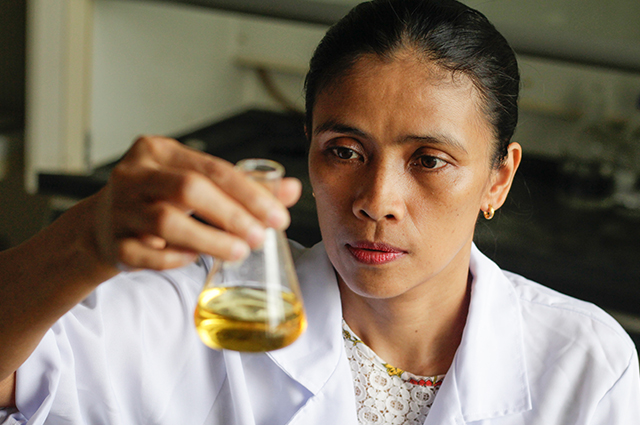
Micronutrient deficiency or hidden hunger refers to vitamin and mineral deficiencies affecting people of all ages and gender regardless of socioeconomic status.
“Symptoms of micronutrient deficiencies are usually unnoticeable until the state of massive chronic disease is reached,” said Dr. Riza A. Ramos of PhilRice’s Rice Chemistry and Food Science Division (RCFSD).
With the research on Acceptability, shelf-life and nutritional quality of Moringa-supplemented rice crackers, Ramos and her colleagues Rosaly V. Manois and Amelia V. Morales turned a junk food into a nutrient-filled food. This research earned Ramos the 2015 Gawad Saka Outstanding Agriculture Researcher award in Central Luzon.
Moringa or locally known as Malunggay, is known the world over as a low-cost solution to undernourishment.
According to Ramos, every part of the tree is nutritious. The leaves have the highest amount of calcium and phosphorus among vegetables. Malunggay is rich in potassium, iron, and vitamin C. Some studies show that it also reduces cholesterol.
That said, malunggay then becomes the perfect ingredient to making nutrient-filled rice crackers.
Ramos drew inspiration for this research from being anemic herself during her preschool years. She said children, pregnant, and lactating women are among the most vulnerable groups for micronutrient deficiency.
For Ramos, the challenge was how to convince children to eat nutritious food items as they generally do not taste good. Hence, she thought of incorporating malunggay in rice crackers.
She added that there are similar efforts being done by local bakeshops to incorporate malunggay in other products. She, however, is unsure if the right amount of malunggay to meet the nutritional requirements is being added.
As we write, Ramos’ team has already made some demonstrations of their product at the Palusapis Fish Cracker Plant Facility in the Science City of Muñoz, Nueva Ecija. This forms part of their efforts to promote their product.
“We offer training programs free of charge mostly to mothers and members of women’s organizations,” said Dr. Ramos.
Based on their research, the malunggay-supplemented rice crackers have lower total fat content and significantly higher beta-carotene, vitamin C, and calcium levels. These nutrients are essential for growing children.
Ramos said the product is now up for grabs by anyone who might want to produce it on a bigger scale. Interested individuals may contact the PhilRice’s RCFSD at 044 456 0258 local 260.
Written by Zenny Awing, Jeson Candole, Kristianne Marie David, Regina Mae Ronquillo, and Julianne Suarez.




